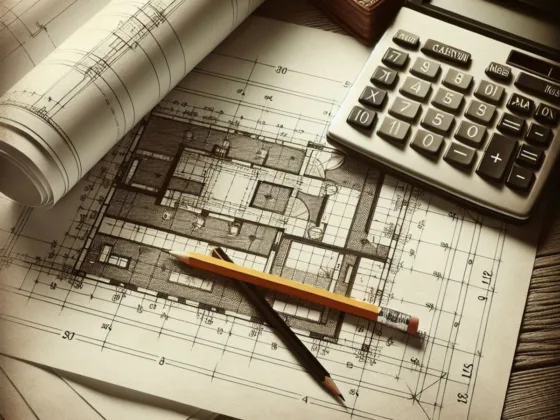Table of Contents Show
Introduction
When we talk about redefining architectural success, it’s time to shine a spotlight on the unsung heroes who ensure our skylines don’t just reach higher, but also stand stronger. Yes, we’re talking about structural engineers—the masterminds whose contribution goes beyond mere calculations. They are the magicians transforming creative visions into safe, sustainable, and sensational realities.
In this deep dive, we unravel the pivotal role of structural engineers in pushing the envelope of architectural design. It’s not just about crafting buildings that wow with their aesthetics; it’s equally about those that excel in functionality. As we peel back the layers of modern architecture, we find structural engineers at its core, balancing the scales between beauty and practicality, ensuring each structure stands up to more than just expectations.
Here’s what to expect:
- How structural engineers have evolved from technical wizards to creative partners.
- The dance of form, function, and structural integrity in iconic buildings.
- Innovative engineering solutions that are reshaping architecture.
- Why diversity in engineering is key to a resilient future.
- The importance of cross-disciplinary collaboration in bringing concepts to life.
- Preparing future talent for the evolving landscape of structural engineering.
- A glimpse into what lies ahead for architectural and structural design synergy.
Armed with insights and examples, let’s gear up to appreciate how structural engineers are not only part of the conversation but are leading it toward redefining what success in architecture truly means.
The Changing Role of Structural Engineers in Architecture

The traditional view of structural engineers as the behind-the-scenes calculators has changed significantly. They used to be responsible for crunching numbers and ensuring stability, but now they are playing a more active role alongside architects in the creative process.
A Shift in Perception
In the past, structural engineers were seen as being solely responsible for technical calculations and feasibility. However, today they are recognized for their creative input, innovation, and problem-solving abilities.
Architectural Partnerships
As pioneers in the field of engineering, structural experts are breaking free from their silos to engage more dynamically with architects. Collaboration is now the buzzword, with both professions understanding that the best structures arise from a symbiotic relationship between form and function.
Examples of Successful Engineer-Architect Partnerships:
- The Shard in London: A shining example of an engineer-architect partnership where innovative structural solutions underpin its unique glass façade.
- Beijing National Stadium (Bird’s Nest): Illustrates how aesthetic concepts can be realized through groundbreaking engineering strategies.
Historical Perspective
In the past, structural engineers were typically brought in to bring an architect’s vision to life. However, this dynamic has changed.
Then and Now:
- Then: The engineer’s voice was often secondary, focused on practicality.
- Now: A dual voice where structural considerations can influence design from inception.
This shift is not just about who gets credit but about how buildings meet evolving aesthetic and functional demands. It’s a renaissance period for construction – one where towering achievements are not merely measured by scale or grandeur but by the seamless integration of design and structure.
By stepping out from behind their technical blueprints, structural engineers are no longer just adding support; they’re helping to shape the skyline. As we witness this role continue to evolve, it becomes clear that when engineers and architects collaborate effectively, they lay down the foundation for architectural masterpieces that stand the test of time—and gravity.
Defying Gravity: The Intersection of Form, Function, and Structural Integrity

When creative design and rigorous engineering come together, the results can be truly stunning. Iconic buildings all over the world are proof of what architects and structural engineers can achieve when they work hand in hand. We will explore how these two disciplines merge to enhance both the appearance and purpose of a structure, making sure that its strength is not compromised by its beauty.
The Three Key Elements of Outstanding Architecture
To understand this collaboration better, let’s first look at the three main components of exceptional architecture:
- Form: This refers to the overall look and style of the building—the part that catches your eye and leaves you in awe.
- Function: It focuses on how well the spaces within the building serve their intended purpose and meet the needs of its users.
- Structural Integrity: Often overlooked but crucial, this element ensures that the building is stable, durable, and safe for occupancy.
These three elements are interconnected; a flaw in one can have a ripple effect on the entire structure. Architects and structural engineers must find a delicate balance between aesthetics, practicality, and strength when designing a building.
Examples of Successful Collaboration
To truly appreciate this partnership, let’s take a closer look at some remarkable structures where architects and structural engineers have worked together seamlessly:
The Gravity-Defying Marvel: CCTV Headquarters
The China Central Television (CCTV) Headquarters in Beijing is an architectural wonder designed by Dutch architect Rem Koolhaas and engineered by Cecil Balmond. Unlike traditional skyscrapers, this building features a unique looped shape with an open center. Its cantilevers support an impressive 473,000 square meters of floor space—an extraordinary display of architectural courage backed by engineering brilliance.
A Symphony in Steel: The Guggenheim Museum Bilbao
Frank Gehry’s masterpiece in Spain is a true testament to the power of collaboration. The visionary design of the Guggenheim Museum Bilbao was brought to life by the structural engineering expertise of Skidmore, Owings & Merrill. They transformed Gehry’s abstract concept into a structurally sound reality through advanced computer modeling and innovative use of materials. The result? A museum that not only houses art but is also a work of art itself, with its curvaceous metallic exterior standing strong against the test of time.
Eco-Conscious Elegance: The California Academy of Sciences
Renzo Piano’s iconic building in San Francisco seamlessly combines sustainability with architectural grandeur. One of its standout features is the living roof—a vibrant tapestry of native plants that helps regulate temperature and reduce energy consumption. To ensure its stability, the structural engineers integrated the roof structure with the surrounding environment while maintaining resilience against seismic activities. This integration of green design principles and structural considerations showcases how modern architecture can be both visually stunning and environmentally responsible.
Each of these examples clearly shows that no single aspect overshadows the others; instead, they blend harmoniously. Every building is not only about its striking appearance but also about the people who occupy it—feeling secure and at ease within its walls, thanks to the meticulous planning and expertise of structural engineering.
Connecting Structure to Residential Spaces
The significance of structural integrity extends beyond monumental public structures—it also plays a crucial role in shaping our everyday living spaces. Elements such as home layout and the materials used in construction directly impact the safety and durability of our homes. For example, earthquake-prone regions require buildings with flexible structures that can withstand seismic forces, ensuring the well-being of their occupants.
Moreover, structural engineering contributes to the aesthetics of residential architecture by enabling open floor plans, expansive windows, and innovative designs that enhance natural light and ventilation. These features not only create a sense of spaciousness but also promote energy efficiency, reducing reliance on artificial lighting and HVAC systems.
Beyond Safety: Sustainable Solutions
In an era when environmental consciousness is paramount, structural engineers are increasingly incorporating sustainable practices into their designs. This includes utilizing eco-friendly materials, integrating renewable energy systems like solar panels or wind turbines, and implementing rainwater harvesting techniques.
By seamlessly integrating these ecological considerations with structural requirements, architects and engineers can create buildings that not only stand tall but also leave a minimal carbon footprint. Such structures serve as beacons of sustainable living, inspiring communities to embrace green practices in their own lives.
Pushing Boundaries: Innovative Solutions by Structural Engineers Shaping Architecture

The role of structural engineering in driving innovation cannot be overstated—these professionals are not just about ensuring stability and safety; they’re about pushing the envelope of what’s possible in architecture. With each new project comes the dual challenge of fulfilling an architect’s vision while adhering to the laws of physics, and it’s this very interplay that propels architectural design forward.
Emerging Trends in Structural Engineering
Advancements in technology have truly expanded the toolkit available for structural expression in buildings:
- Materials Science Breakthroughs: Innovations such as ultra-high-performance concrete (UHPC), carbon fiber reinforcements, and shape-memory alloys allow for stronger, more flexible, and lighter structures. These materials redefine limitations, enabling bolder architectural forms.
- Digital Design and Fabrication: With tools like Building Information Modeling (BIM) and 3D printing, structural engineers can envision complex geometries with precision. Digital simulations predict performance long before physical construction begins, mitigating risk and enhancing creativity.
- Sustainable Engineering Practices: As global emphasis on sustainability grows, structural engineers are at the forefront of eco-friendly design. From optimizing material use to integrating energy-producing features, they ensure that innovation also means conservation.
Case in Point: Technology-Driven Structural Solutions
Consider the marvels like the CCTV Headquarters in Beijing or the undulating curves of The Heydar Aliyev Center in Baku. These structures stand as testaments to how far we’ve come—where once there were straight lines and right angles, now there are curves, twists, and forms defying simple categorization.
Yet, innovation isn’t just about iconic landmarks; it’s equally about advancements that transform everyday building practices. The use of ingenious construction tools and machines has revolutionized on-site work. From precise cutting equipment to advanced cranes capable of negotiating complex geometry, these innovations streamline processes and open up new possibilities for architectural expression.
By embracing these emerging trends, structural engineers don’t just respond to architects’ aspirations—they inspire them. In these collaborative ventures, each boundary pushed is a step toward a future where our built environment isn’t just functional but is also a canvas for human ingenuity.
Embracing Diversity for a More Resilient Future
Diversity and inclusion are not just buzzwords in the corporate world. These principles have tangible, far-reaching benefits in various industries, and structural engineering is no exception. By fostering a diverse workforce, the industry can tap into a broader range of perspectives, skills, and experiences. This diversity fuels innovative solutions to complex architectural problems, ultimately leading to more resilient structures.
Looking at the industry’s current landscape reveals a pressing issue: underrepresentation of certain groups. Women, for instance, make up only about 14% of engineers overall, according to data from the American Society of Civil Engineers. People of color face similar challenges in representation.
Addressing this issue isn’t just about promoting fairness—it’s about enhancing problem-solving capabilities within the field. Diverse teams bring unique insights that homogenous teams might overlook.
To promote diversity in the structural engineering industry, several steps can be taken:
- Outreach programs: Building awareness about structural engineering as a career path among underrepresented communities can spark interest and attract new talent.
- Scholarships and funding opportunities: Financial support can break down barriers to education for underprivileged individuals who have an interest in engineering.
- Mentorship programs: Experienced engineers mentoring newcomers can provide invaluable guidance and support, thereby increasing retention rates in the field.
- Inclusive workplace practices: Employers must foster an inclusive environment that values every individual’s contributions regardless of their background.
But these steps aren’t the end-all solution—they’re starting points that demand consistent effort. The structural engineering community must continuously strive for greater diversity and inclusion to build a stronger, more innovative industry.
The road may be challenging but it’s one worth taking. A diverse structural engineering industry doesn’t just mean better buildings—it means better solutions for everyone who uses those buildings. So let’s turn our focus on how we can foster more effective communication and collaboration in this diverse industry.
Building Bridges: Enhancing Communication and Collaboration between Architects, Structural Engineers, and Other Stakeholders
In the world of architecture, every professional – from architects to structural engineers, and more – brings their own unique skills and knowledge to the table. It is through the seamless collaboration and understanding between these different roles that a project can transcend its initial concept and become a true work of art. In the AEC (architecture, engineering, and construction) industry, effective communication and interdisciplinary collaboration are crucial for the success of architectural projects.
Key Principles for Effective Collaboration:
- Open Dialogue: Creating an environment where ideas can flow freely allows for the emergence of innovative solutions. Encourage regular meetings and use language that is easy for everyone to understand.
- Shared Vision: Ensuring that all team members are aligned with a common goal guarantees that everyone is working towards the same outcome. This unity can often be fostered through workshops or team-building activities.
- Respect for Expertise: Acknowledging the value of each professional’s specialized knowledge is essential. When architects appreciate the intricate calculations of engineers, and vice versa, mutual respect becomes the foundation of collaboration.
- Integrated Processes: Utilizing tools like Building Information Modeling (BIM) can streamline workflows and enhance coordination among all parties involved in a project.
- Continuous Learning: Keeping up-to-date with developments in each other’s fields cultivates an atmosphere of growth and adaptability – crucial in an industry that’s constantly evolving.
By implementing these strategies, professionals in the AEC industry can strengthen their collaborative efforts. However, it’s important to remember that effective collaboration requires more than just speaking; it entails active listening – truly understanding and addressing the perspectives and concerns of every stakeholder involved.
“Effective collaboration isn’t just about talking; it’s about listening – truly hearing the insights and concerns of every stakeholder involved.”
The Significance of Accurate Construction Estimates
In addition to effective collaboration, accurate construction estimates play a vital role in the success of a project. They provide the foundation for financial planning and resource allocation, ensuring that the necessary funds and materials are available throughout the construction process.
“Accurate construction estimates are integral to project success; they lay the groundwork for financial planning and resource allocation.”
To delve deeper into this critical aspect of architectural projects, you can explore TimeWornLit, which offers valuable insights into the essential role of construction estimates within the industry.
Fostering Innovation through Diverse Perspectives
As we explore different viewpoints on architectural success, one thing becomes clear: when communication flourishes amidst diversity of thought and expertise, innovation is not far behind. With each connection made between different disciplines, we create opportunities for groundbreaking ideas and collaborative excellence.
“With every bridge built between disciplines, we pave the way towards structures that not only reach towards the sky but also deeply root themselves in collaborative excellence.”
Preparing the Next Generation of Structural Engineers
As the architectural landscape shifts, so too must the education of those who shape it. The future of structural engineering is poised on the precipice of change, and the world will lean heavily on the shoulders of the next generation of engineers to navigate this new terrain.
The Evolving Role of Education
The role of education in shaping these future trailblazers cannot be understated. Traditional engineering curriculum, grounded in a solid understanding of materials, mechanics, and mathematics, remains a necessary foundation. However, structural engineering education now has a critical need to evolve beyond these basics.
Expanding the Skill Set
The challenge lies in equipping budding engineers with an updated toolkit. One that includes not just technical knowledge, but also an understanding of architectural design principles, sustainability concepts, and innovative construction methods. It’s about fostering a holistic view of building design that integrates aesthetics and functionality seamlessly.
Embracing Technology
A crucial part of this evolution involves embracing technology. The integration of digital tools and computational methods into the curriculum is no longer optional; it’s essential. Here are two ways technology is reshaping structural engineering education:
- Software Proficiency: Today’s structural engineers need to be adept at using advanced software tools for tasks like computer-aided design (CAD), building information modeling (BIM), and finite element analysis (FEA). These tools enable efficient design, analysis, and visualization of complex structures.
- Computational Design: This approach leverages algorithms to generate a wide range of design solutions based on specific parameters. It allows engineers to explore unconventional forms and structures that would be difficult to conceive manually.
By immersing students in such technologies during their studies, educational institutions can prepare them for a professional environment that increasingly relies on digital solutions.
Striking a Balance
In essence, preparing the future generation of structural engineers requires a progressive blend of tradition and innovation. While it’s important to respect time-tested principles, there’s also a pressing need to adapt to the changing demands of the profession. And with the right education, these future engineers will indeed be ready to redefine architectural success.
Looking Ahead: The Future of Architectural and Structural Design Integration
As we look ahead to the future of architecture and structural engineering, it’s evident that there are both exciting possibilities and significant obstacles on the horizon. New trends like sustainable design and modular construction are poised to revolutionize our approach to achieving architectural excellence.
Sustainable Design: A Collaborative Effort
Sustainability is no longer a niche consideration but an essential aspect of building design. Architects and structural engineers will need to work closely together to create structures that not only meet aesthetic and functional requirements but also have minimal environmental impact. This could involve:
- Using renewable materials
- Optimizing energy consumption
- Integrating green spaces into building designs
Consider the growing popularity of green roofs and walls as an example. These features aren’t just visually appealing; they also offer benefits such as improved insulation, reduced stormwater runoff, and habitat creation for local wildlife. However, achieving these advantages requires a deep understanding of both architectural principles and structural engineering concepts.
Modular Construction: The Art of Coordination
Modular construction presents another exciting opportunity for innovation. By assembling buildings from pre-fabricated modules, we can:
- Save time
- Reduce waste
- Improve safety on construction sites
However, this method also demands a new level of coordination between architects and structural engineers.
In traditional construction methods, architects may have more flexibility in their designs because they can make adjustments on-site. However, in modular construction, each piece must be designed in advance to fit together perfectly. This necessitates the involvement of structural engineers from the very beginning of the design process.
The Influence of Technology: Enhancing Collaboration
Advancements in technology will continue to shape the relationship between architecture and structural engineering. For example, developments in digital modeling software allow architects and engineers to visualize complex structures before they’re built[^1^]. This can facilitate better communication and collaboration between the two professions.
The Road Ahead: Challenges and Opportunities
The future landscape of architectural design integration presents a mix of challenges and opportunities. Sustainable design and modular construction offer new ways to create innovative and environmentally conscious structures. However, they also require architects and structural engineers to work closely together, emphasizing the importance of collaboration in achieving successful outcomes.
Ultimately, as the field of architecture evolves, it’s clear that structural engineers will play a vital role in navigating this changing terrain. Their expertise in understanding the technical aspects of building design will be crucial in realizing architectural visions that are both functional and sustainable.
[^1^]: Digital modeling software has facilitated better communication and collaboration between architects and engineers by allowing them to visualize complex structures before they’re built. This has been particularly useful in saving construction time with barndominiums, an emerging trend in the industry.Conclusion
Redefining architectural success isn’t just about creating visually appealing structures. It’s about embracing the multidisciplinary nature of the process and acknowledging the pivotal role of structural engineers in shaping a more holistic approach.
Structural engineers contribute to every stage of a project, from initial design concepts to the final construction details. Their technical expertise, combined with their ability to problem-solve and innovate, ensures that buildings are not only beautiful but also functional, safe, and sustainable.
The future of architecture and engineering is exciting and promising. The integration of sustainable design principles, innovative construction methods, and digital technologies will continue to push the boundaries of what’s possible.
So here’s a call to action for all readers:
- Support Collaboration: Architects, engineers, contractors – everyone involved in a project can learn from one another. Promote interdisciplinary collaboration in your projects for better results.
- Embrace Innovation: Stay abreast of emerging trends and technologies in the industry. Use them as tools to drive creativity and efficiency in your work.
- Advocate for Diversity: Diversity fosters innovation. Champion equal opportunities for everyone in the architecture and engineering industries.
Remember, each building we design and construct is a testament not just to our creative vision, but also to our commitment to collaboration, innovation, and diversity. Let’s redefine architectural success together.
Citation
Quora. (n.d.). Why do architects get more fame than structural engineers, even though both have the same importance in a project? Retrieved March 23, 2024, from https://www.quora.com/Why-do-architects-get-more-fame-than-structural-engineers-even-though-both-have-the-same-importance-in-a-project
FAQs (Frequently Asked Questions)
The key takeaway is recognizing the crucial role of structural engineers in redefining architectural success by balancing aesthetics and functionality.
The role of structural engineers has evolved from being seen as purely technical experts to becoming design collaborators, working closely with architects.
Effective communication and interdisciplinary collaboration are significant for successful outcomes in architectural projects, fostering a culture of teamwork between design professionals and engineering experts.
Diversity and inclusion are important in fostering innovation and resilience within the structural engineering industry, addressing the underrepresentation of certain groups, and promoting equal opportunities for diverse talent.
Education is evolving by integrating digital tools and computational methods into the curriculum to equip future structural engineers with the skills needed to navigate the changing demands of the profession.
Emerging opportunities and challenges include advancements in areas such as sustainable design and modular construction that will shape the collaboration between architects and structural engineers in the future.










